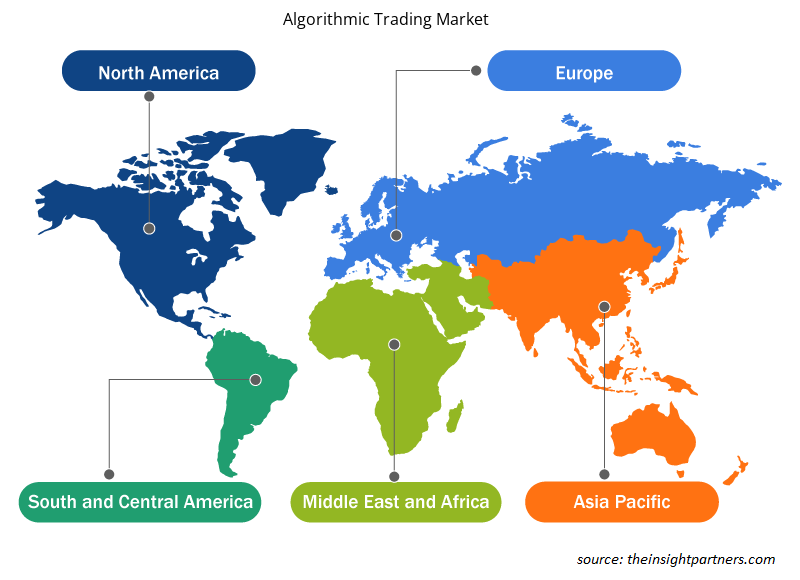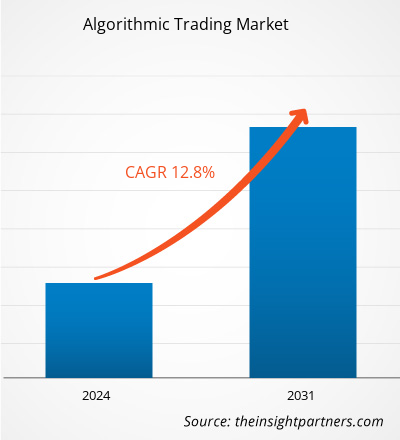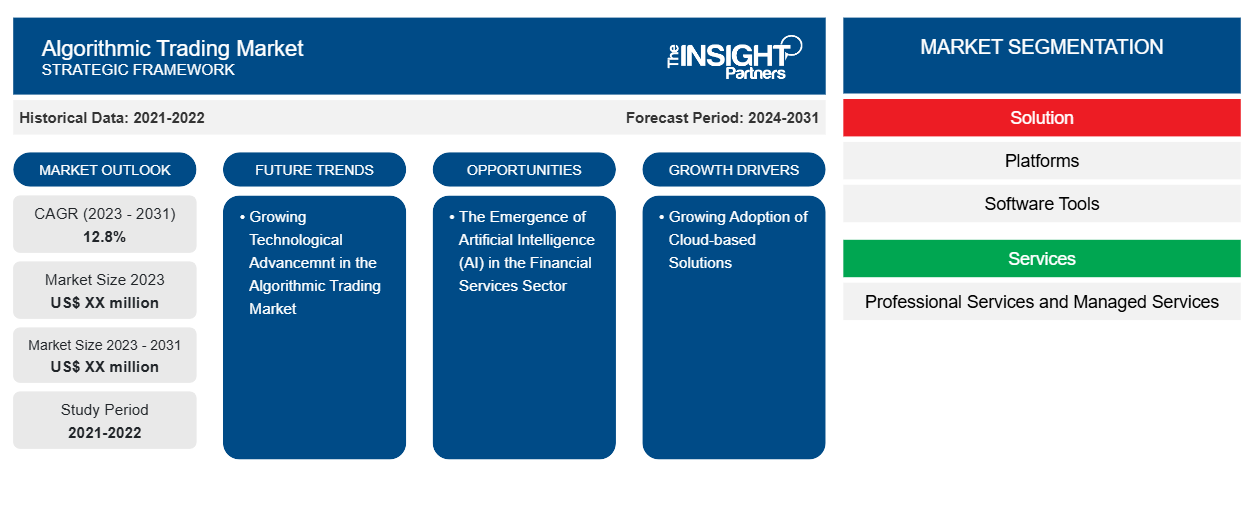Si prevede che la dimensione del mercato del trading algoritmico raggiungerà un CAGR del 12,8% dal 2023 al 2031. Dall'introduzione dei motori di matching negli exchange moderni, il trading algoritmico è stato utilizzato in tutto il mondo. Eliminando le restrizioni umane, tali progressi tecnologici hanno migliorato la capacità dei mercati di elaborare transazioni e ordini. Guidando così la crescita del mercato del trading algoritmico.
Analisi di mercato del trading algoritmico
Si prevede che la necessità di trading algoritmico sarà guidata da linee guida governative favorevoli, dalla crescente domanda di esecuzione degli ordini affidabile, rapida ed efficace, dall'aumento della domanda di sorveglianza del mercato e dalla diminuzione dei costi di transazione. I grandi investitori istituzionali e le società di intermediazione utilizzano il trading algoritmico per ridurre le spese del trading di massa. Inoltre, si prevede che lo sviluppo di algoritmi di servizi finanziari e di intelligenza artificiale (IA) genererà opportunità di espansione del mercato redditizie durante il periodo di previsione. Si prevede inoltre che un aumento della domanda di soluzioni basate su cloud supporterà la crescita del mercato del trading algoritmico.
Panoramica del mercato del trading algoritmico
- Il trading algoritmico è un tipo di automazione in cui un programma per computer viene utilizzato per eseguire in modo efficiente una serie definita di istruzioni o linee guida che comprendono la vendita o l'acquisto di un asset in base a diversi dati di mercato.
- Inoltre, i set definiti di regole o istruzioni si basano su quantità, prezzo, tempistica o qualsiasi modello matematico. Investitori e trader stanno adottando soluzioni di trading algoritmico in quanto li aiutano a eseguire le negoziazioni ai migliori prezzi possibili.
Personalizza questo report in base alle tue esigenze
Riceverai la personalizzazione gratuita di qualsiasi report, comprese parti di questo report, o analisi a livello nazionale, pacchetto dati Excel, oltre a usufruire di grandi offerte e sconti per start-up e università
-
Scopri le principali tendenze di mercato in questo rapporto.Questo campione GRATUITO includerà analisi di dati che spaziano dalle tendenze di mercato alle stime e alle previsioni.
Driver di mercato del trading algoritmico
L'emergere dell'intelligenza artificiale (IA) nel settore dei servizi finanziari per guidare il mercato del trading algoritmico
- Diverse società di servizi finanziari stanno incrementando l'adozione di AI e machine learning per sfruttare le informazioni provenienti da canali digitali. Ciò ha ulteriormente portato allo sviluppo di una tendenza agli investimenti basati sui dati negli ultimi anni.
- L'utilizzo del trading algoritmico è in forte crescita grazie alla sua completa automazione, alla facilità di diversificazione e alla rapida esecuzione delle negoziazioni.
Analisi della segmentazione del rapporto di mercato del trading algoritmico
- In base all'implementazione, il mercato del trading algoritmico è segmentato in on-premise e basato su cloud. Si prevede che il segmento basato su cloud detiene una quota di mercato sostanziale del trading algoritmico nel 2023.
- Si prevede che le piattaforme di trading algoritmico basate su cloud svolgeranno un ruolo cruciale nella crescita del mercato, grazie a vari vantaggi, come l'ottenimento del massimo profitto, l'automazione delle procedure di trading, la facile manutenzione dei dati di trading, la scalabilità, la convenienza e la gestione efficiente.
Analisi della quota di mercato del trading algoritmico per area geografica
L'ambito del mercato del trading algoritmico è principalmente suddiviso in cinque regioni: Nord America, Europa, Asia Pacifico, Medio Oriente e Africa e Sud America. Il Nord America ha dominato la quota di mercato del trading algoritmico nel 2023. La crescita regionale può essere attribuita alla presenza di diversi attori del mercato nella regione. Questi fornitori stanno anche implementando varie strategie di crescita per rafforzare la loro posizione nel mercato. Si prevede che numerosi fattori, come i crescenti investimenti nelle tecnologie di trading e il crescente supporto governativo per le attività di trading globali, contribuiranno alla crescita regionale del mercato nordamericano durante il periodo di previsione.
Approfondimenti regionali sul mercato del trading algoritmico
Le tendenze regionali e i fattori che influenzano il mercato del trading algoritmico durante il periodo di previsione sono stati ampiamente spiegati dagli analisti di Insight Partners. Questa sezione discute anche i segmenti e la geografia del mercato del trading algoritmico in Nord America, Europa, Asia Pacifico, Medio Oriente e Africa e America centrale e meridionale.

- Ottieni i dati specifici regionali per il mercato del trading algoritmico
Ambito del rapporto di mercato sul trading algoritmico
| Attributo del report | Dettagli |
|---|---|
| Dimensioni del mercato nel 2023 | XX milioni di dollari USA |
| Dimensioni del mercato entro il 2031 | XX milioni di dollari USA |
| CAGR globale (2023-2031) | 12,8% |
| Dati storici | 2021-2022 |
| Periodo di previsione | 2024-2031 |
| Segmenti coperti |
Per soluzione
|
| Regioni e Paesi coperti |
America del Nord
|
| Leader di mercato e profili aziendali chiave |
|
Densità degli attori del mercato del trading algoritmico: comprendere il suo impatto sulle dinamiche aziendali
Il mercato del trading algoritmico sta crescendo rapidamente, spinto dalla crescente domanda degli utenti finali dovuta a fattori quali l'evoluzione delle preferenze dei consumatori, i progressi tecnologici e una maggiore consapevolezza dei vantaggi del prodotto. Con l'aumento della domanda, le aziende stanno ampliando le loro offerte, innovando per soddisfare le esigenze dei consumatori e capitalizzando sulle tendenze emergenti, il che alimenta ulteriormente la crescita del mercato.
La densità degli operatori di mercato si riferisce alla distribuzione di aziende o società che operano in un particolare mercato o settore. Indica quanti concorrenti (operatori di mercato) sono presenti in un dato spazio di mercato in relazione alle sue dimensioni o al valore di mercato totale.
Le principali aziende che operano nel mercato del trading algoritmico sono:
- 63 tecnologie lune limitate
- AlgoTrader
- Ingegneria del software Argo
- Informazioni su InfoReach, Inc.
- Azienda
- MetaQuotes Ltd.
Disclaimer : le aziende elencate sopra non sono classificate secondo un ordine particolare.

- Ottieni una panoramica dei principali attori del mercato del trading algoritmico
"Analisi di mercato del trading algoritmico"è stato effettuato in base a tipo, modalità, canale di distribuzione e geografia. In base alla soluzione, il mercato è suddiviso in piattaforme e strumenti software. In base alle prospettive di servizio, il mercato è suddiviso in servizi professionali e servizi gestiti. In base all'implementazione, il mercato è suddiviso in cloud e on-premise. In base ai tipi di trading, il mercato è suddiviso in cambi (FOREX), mercati azionari, fondi negoziati in borsa (ETF), obbligazioni, criptovalute e altri. In base al tipo di trader, il mercato è suddiviso in investitori istituzionali, trader a lungo termine, trader a breve termine e investitori al dettaglio. In base alla geografia, il mercato è segmentato in Nord America, Europa, Asia Pacifico, Medio Oriente e Africa e Sud America.
Notizie di mercato e sviluppi recenti del trading algoritmico
Le aziende adottano strategie inorganiche e organiche come fusioni e acquisizioni nel mercato. Di seguito sono elencati alcuni dei recenti sviluppi chiave del mercato:
- Nell'ottobre 2022, Refinitiv, un'azienda LSEG, ha annunciato l'introduzione di una soluzione di onboarding digitale globale personalizzata, sicura e senza attriti per supportare le aziende nell'ottimizzazione del loro approccio all'onboarding dei clienti. La soluzione di onboarding digitale dei clienti di Refinitiv fornisce un'interfaccia utente completamente configurabile, consentendo alle organizzazioni di offrire il processo di applicazione del prodotto che può essere fornito tramite dispositivi mobili, Web e API. [Fonte: Refinitiv, sito Web aziendale]
Copertura e risultati del rapporto di mercato sul trading algoritmico
La previsione del mercato del trading algoritmico è stimata in base a vari risultati di ricerche secondarie e primarie, come pubblicazioni aziendali chiave, dati di associazioni e database. Il rapporto di mercato "Dimensioni e previsioni del mercato del trading algoritmico (2021-2031)" fornisce un'analisi dettagliata del mercato che copre le seguenti aree:
- Dimensioni e previsioni del mercato a livello globale, regionale e nazionale per tutti i principali segmenti di mercato interessati dall'indagine.
- Dinamiche di mercato quali fattori trainanti, limitazioni e opportunità chiave.
- Principali tendenze future.
- Analisi PEST e SWOT dettagliate
- Analisi del mercato globale e regionale che copre le principali tendenze del mercato, gli attori chiave, le normative e i recenti sviluppi del mercato.
- Analisi del panorama industriale e della concorrenza che comprende la concentrazione del mercato, l'analisi della mappa di calore, gli attori chiave e gli sviluppi recenti.
- Profili aziendali dettagliati.
- Analisi storica (2 anni), anno base, previsione (7 anni) con CAGR
- Analisi PEST e SWOT
- Valore/volume delle dimensioni del mercato - Globale, Regionale, Nazionale
- Industria e panorama competitivo
- Set di dati Excel
Report recenti
Testimonianze
Motivo dell'acquisto
- Processo decisionale informato
- Comprensione delle dinamiche di mercato
- Analisi competitiva
- Analisi dei clienti
- Previsioni di mercato
- Mitigazione del rischio
- Pianificazione strategica
- Giustificazione degli investimenti
- Identificazione dei mercati emergenti
- Miglioramento delle strategie di marketing
- Aumento dell'efficienza operativa
- Allineamento alle tendenze normative























 Ottieni un campione gratuito per - Mercato del trading algoritmico
Ottieni un campione gratuito per - Mercato del trading algoritmico